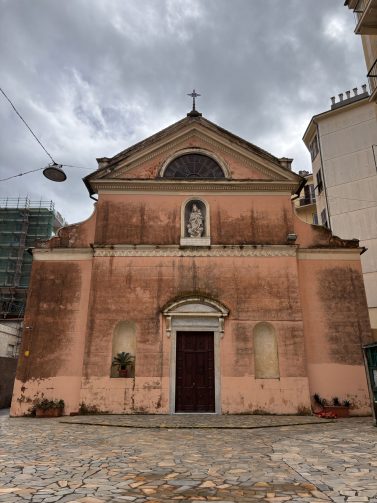The cult of Our Lady of the Snows originated from a legend, namely the miraculous snowfall that allegedly occurred on the night of August 4-5, 4th century, in Rome on the Esquiline Hill, a place where in a dream Our Lady indicated to both Pope Liberius and a Roman patrician, John, the construction of a Church. It later became the site of the famous Basilica of Santa Maria Maggiore, also known as Santa Maria della Neve.
Savona, the provincial capital of Liguria, also has its own church dedicated to Our Lady of the Snows, in the heart of the Fornaci district, on Saredo Street. Built in 1667, but completely rebuilt in 1887, designed by architect Giuseppe Cortese, today it is divided into three naves. Inside we find a significant fresco, in the vault of the nave, called “The Vision of Pope Liberius,” depicting the miracle of the Madonna of the Snow.
The fresco was created in the first half of the last century by Piedmontese artist, but transplanted to Liguria, Giovanni Rovero.
The reference to the miracle that occurred in the fourth century on the Esquiline Hill is clear: below are on the left Roman patrician John and his wife gathered in prayer and on the right Pope Liberius gazing in the distance at the church, almost certainly the Basilica of Santa Maria Maggiore, completely whitewashed.
Another work of great interest is the painting behind the high altar, at the bottom of the apse, depicting Our Lady of the Snow among the Angels. Unknown to the artist, probably of Savona origin, the work features the iconographic element par excellence, namely snow, although it is difficult to identify. Interesting, however, is the depiction of the child Jesus, in the arms of Our Lady, smiling, holding the Earth Globe in his left hand. Despite the clear reference to Our Lady of the Snows, the Church of the Fornaci over the years has welcomed other Marian iconographies, always dear to Savona’s tradition.
For example, the painting by the well-known Savona artist Gerolamo Brusco, present on the right wall, depicting Our Lady of Mercy, patroness of the city, who appeared in the valley of the Sanctuary in 1536. Also of great interest is the sculpture depicting the Virgin, by Antonio Brilla, present at the entrance to the church.
The unbreakable bond between the Fornaci neighborhood and Our Lady of the Snows is also found in the traditional Procession on August 5. Every year the statue of the Virgin arrives by sea at the neighborhood’s landing place, namely the Scaletto dei Pescatori, and is welcomed with a procession through all the streets of Fornaci, followed by Mass in the churchyard.
An important moment for the community of the Fornaci neighborhood, which gathers together to celebrate its patron saint with faith and devotion.









